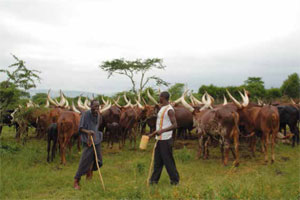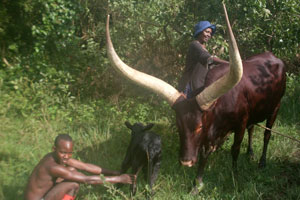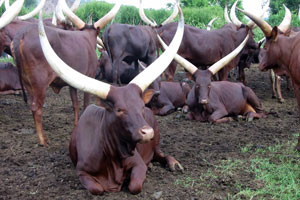Ankole Longhorn cattle can survive in extremely harsh, dry conditions such as those in sub-Saharan Africa – which is becoming drier and hotter. In a context where herders are strongly encouraged to keep exotic and hybrid cattle, the innovative LIFE approach led Ugandan herders to revalue the Longhorns for their economic and cultural value.
Ankole Longhorns are one of the oldest indigenous cattle breeds of Uganda. They have striking, long, large-diameter horns, which assist their blood circulation and help keep them cool during hot temperatures. They are renowned for their hardiness, which allows them to forage on poor quality vegetation and live off limited amounts of water.
Their keepers, the Bahima, are an ethnic pastoral group of the Ankole people who reside in an area stretching from the South West to the North East of Uganda.
Extinction and loss

Uganda is at risk of losing the valuable Ankole Longhorn species. There are two major reasons for this. Since the mid 1990s, Ugandan government programmes have promoted indiscriminate cross-breeding of Ankole Longhorn cows with other exotic cattle. Exotic breeds such as Frisian cows produce more milk and need less land to graze on. But this breeding programme, if continued, will lead to the extinction of the indigenous breed. In addition, increased human population – among other factors – has reduced the grazing land available for Bahima herders. Many of them have been forced to sell off a significant portion of their Longhorn cattle and switch to grazing smaller herds of exotic and hybrid breeds. And the impact is clear. The government estimated the exotic and crossbred cattle population in 2006 at 17.3%, compared to 4.4% in 1997.
Along with the loss of the Ankole Longhorns, cultural traditions and indigenous knowledge about animal breeding are also disappearing. For instance, elders told us about medicinal herbs they used to treat cows with birthing problems or infections or specific ways of selecting the cows that would produce more milk.
Are exotic cows really better?
In the short term, there seem to be many benefits to exotic and hybrid cows: they need less land to graze on, produce a lot of milk and meat and thus bring in more income. However, this is only the case when conditions are favourable, for these exotics and hybrids have poor resistance to harsh environments and climatic stresses such as those that Uganda has experienced in recent years.
For example, they are prone to going blind when bushes and sharp grasses prick their eyes as they graze, and muddy and flooded land easily makes them ill. They get weak and stressed when temperatures increase above 33° C and walking during droughts tires them easily. During a long dry spell from August 2010 to March 2011 and during floods at the end of 2011, many Frisian and hybrid cattle died – while the Ankole Longhorn cattle endured.
Herders who switched to Frisian cows had to cut down trees and bushes to create grazing land, started using a lot of antibiotics and acaricides and sprayed the foreign breeds with dangerous chemicals. This makes the exotic cattle an expensive herd to manage, and has resulted in the loss of much habitat for biodiversity.
In comparison, the sustainable grazing practices of the Longhorn actually increase species diversity and maintain the ecosystem structure. They keep vegetation cover, which contributes to the reduction of fires, drought and flooding. In addition, scientists have proven that Ankole milk and meat are healthier and more nutritious than the products from the exotic and hybrid breeds. The local population prefer their taste.
In the long term, exotic breeds have caused great financial stress to relatively poor herders and are threatening biodiversity.
Giving LIFE

In 2009-2010, the Pastoral and Environmental Network in the Horn of Africa (PENHA) Uganda and the League for Pastoral Peoples and Endogenous Development (LPP) mobilised Ankole Longhorn cattle keepers in Uganda to document the significance of their cattle. For this they used the LIFE approach, developed by Local Livestock for the Empowerment of Rural People (LIFE) Network, with the aim of promoting the conservation of indigenous breeds among their traditional keepers, by drawing on their knowledge, concepts and priorities, The LIFE approach treats breeds as a product of social networks that operate according to certain rules.
Using informal inquiries, interviews and discussions, conversations and scientific and anthropological studies, and working with traditional story tellers, community elders and local experts, the Bahima communities recorded what they know about Ankole Longhorn cattle. For example they recorded how their great-grandparents carried out selective breeding and other valuable practices that have kept the Ankole Longhorns around for centuries. In doing so the herders realised the value of their breed and their own value as custodians of this breed.
After documenting their knowledge, the Bahima herders started to share it with the rest of the world, realising they wanted to protect their heritage. They were proud of contributing to the conservation of this breed and local biodiversity. The knowledge they documented is now being used in advocacy campaigns for the conservation and protection of the Ankole Longhorns and being disseminated to other farmers, through radio programmes for instance.
Wide appreciation for Ankole Longhorns
The impact of sharing this knowledge is tremendous. Learning from the Bahima experience, many other herders are considering shifting back to breeding the treasure they were almost bringing to extinction. Many Bahima people, including my uncle Mzee Kyomukuku Yokaana, regret selling off their indigenous breeds and have vowed to go back to rearing Ankole Longhorns. They have realised that their indigenous breed is a form of insurance against extreme weather conditions. The work of the Bahima has also inspired other communities to embrace this breed, which was traditionally kept by the Bahima.
Several associations of Bahima herders, such as the Ankole Longhorn Cattle Cow Conservation Association and Cow Protection Conservancy Uganda, are recruiting people and sensitising them to the importance of this indigenous breed. Having a pastoralist background himself, the President of Uganda initiated one of these associations. He called upon herders to save the indigenous breed from extinction by doing what our ancestors used to do: selective breeding so that they produce more milk and thus can compete with the Frisian breeds.
The Chairman of this association, Nayebare Kyamuzigita, says “the main reasons the President is encouraging us to save our breed is because they are more adapted and resistant to the harsh conditions of Uganda, because their by-products like the horns have a lot of value, and because their beauty makes them a tourist attraction. Even the President sees that it is not cost effective to keep exotic cows.”
Plans are underway to create special niche markets for Longhorn milk and meat. At present there are no separate market channels for Longhorn products, which are collected and marketed with other diary and meat products.
Learning from LIFE
In many places around the world, introduced breeds and varieties are promoted with the promise of high yields. But when a community reflects on their past and their opportunities, they are likely to see that high yields may not compensate for the high costs of external inputs such as extra medicines, for the loss of taste and nutritional value, or that of the cultural value associated with the crop or breed. The LIFE Approach encourages owners to appreciate their breeds, continue in situ breeding, and lobby for their rights as the keepers of these precious animal genetic resources.
Yet some challenges remain. Government policy still forces the pastoralists to leave their livelihood and promotes the modernisation of agriculture, while rich investors, national parks and oil companies threaten the land on which the Bahima and the Ankole Longhorn cattle depend. Such land issues endanger the biodiversity benefits that the Bahima and their traditional cattle provide. For this reason, it is important for us herders and our supporters to keep lobbying for our rights and for the significance of our indigenous breeds.
Elizabeth Katushabe
Elizabeth Katushabe works for PENHA and is an Ankole Longhorn cattle keeper herself.
For more information visit www.pastoralpeoples.org or www.penhanetwork.org, or contact elizabethkatushabe@yahoo.com
The many uses of the Ankole Longhorn cattle

Socio-cultural uses
Our status is rated by the number and beauty of the cattle we possess. The Longhorn cattle function as dowry, are used to strengthen friendship and resolve conflicts and for cleansing sins. Their hides are used for making clothes, mats and bedding, their horns are used for making beads, trumpets and violins. Their urine is used for cleaning containers for churning milk and keeping yogurt. Their tasty milk has a high fat content and the tender meat is low in cholesterol. Ghee is served as a special sauce and the Bahima used to make bread and gravy from its blood.
Economic uses
Our cattle live long lives and rarely fall ill. They are resistant to hunger and drought and are a source of income as they produce good dung for biogas. Their maintenance costs us little: they survive on only grass and water under any conditions and can be owned and managed even by poor herders. Income from selling cattle allows us to pay for our children’s school fees.
Agricultural uses
Dung is used as manure for grass and plantations.
Medicinal uses
A mixture of Ankole Longhorn milk and urine is used to treat stomach pains, fever and coughs. Dung is used for making casts for broken bones, for treating measles and stopping the lactation of women who have lost a baby. The horns are used to make a medicine for reducing pain and for giving enemas. The boiled hooves are a source of calcium and can be used to reduce joint pains.

